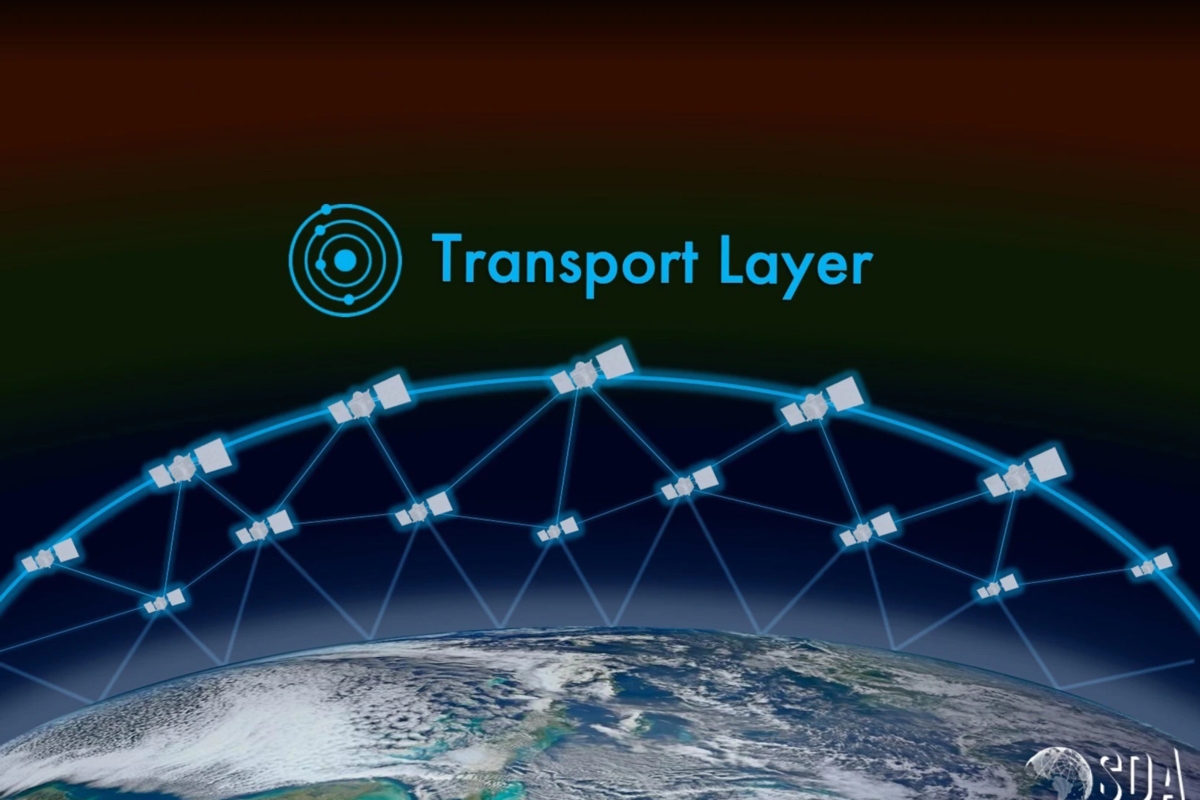SDA Considers PNT Payloads for Future NDSA Satellites

The transport layer in the Space Development Agency’s National Defense Space Architecture (NDSA). Photo: SDA
Hundreds of future satellites under the National Defense Space Architecture (NDSA) may carry GPS-type payloads to complement, improve, and back-up GPS satellites, per the Department of the Air Force Space Development Agency (SDA).
SDA is “interested in proliferating a low-cost L-band Position, Navigation and Timing (PNT) service as a payload on the SDA Tranche 2 Transport Layer,” per a Nov. 3 Request for Information (RFI).
“The PNT payload would include an on-orbit reprogrammable PNT signal generator, mid-size high powered amplifier (HPA), and associated fixed wide beamwidth antenna,” the RFI said. “The goal is to proliferate this low-cost payload onto hundreds of satellites within future SDA Tranches – potentially as early as Tranche 2. Ideally, solutions will be highly informed by the Tranche 1 Transport Layer and share technical approaches and hardware where possible as size, weight, power, cost, technical readiness and manufacturability will be significant constraints.”
SDA, which has a motto of semper citius, Latin for “always faster,” plans to launch NDSA tranches every two years. Satellites in Tranche 1, which is to provide regional tactical data links, advanced missile detection, and beyond line of sight targeting, are to launch in fiscal 2024. Tranche 2, which is to integrate Tranche 1 for global application, is to launch in fiscal 2026.
“Consistent with the continued evolution of the NDSA capabilities, the DoD and U.S. combatant commands have identified the SDA proliferated LEO constellation as a potential source for the transmission of a PNT service that would complement, augment, and, in extreme circumstance, back-up to GPS,” SDA’s Nov. 3 RFI said. “In this way, the SDA PNT service could serve as a forward-looking capability within NAVWAR [Navigation Warfare] resilience planning and operations. Implementation of the SDA PNT service would be compatible with military service planned software-defined PNT receiver user equipment programs (SDUE) and, potentially, as a software upgrade to the Modernized GPS User Equipment (MGUE) Increment 2 program.”
The RFI said that the agency “expects” a high-Technology Readiness Level solution “with preference for COTS devices with space pedigree–inferring manufacturing cost reduction through volume and availability.”
“This system may require two separate amplifiers and associated diplexer; SDA is interested both in the single wideband HPA and the two amplifier approach,” per the RFI. “The low-cost SDA on-orbit reprogrammable PNT signal generator should also minimize SWAP-C, likely utilizing either an SDR [software-defined radio] or FPGA [field-programmable gate array].”
While the Pentagon has considered 11 alternatives to GPS, DoD’s PNT Oversight Council has emphasized the envisioned move to the anti-jamming, anti-spoofing, encrypted M-code GPS signal and should instead prioritize GPS alternatives, according to a Government Accountability Office (GAO) report in August for the Senate Armed Services Committee.
The council, co-chaired by the Pentagon acquisition chief and the vice chairman of the Joint Chiefs of Staff, “has largely prioritized modernizing the existing GPS system over alternative PNT efforts during recent meetings and has no strategic objectives or metrics to measure progress on the alternative efforts,” per the GAO report. “Defined objectives and metrics would help the council better measure overall performance and mitigate any potential gaps in PNT capabilities as the military transitions to using M-code.”
Four of the 11 alternative to GPS efforts are multi-PNT receivers–open systems boxes able to integrate multiple sources of PNT–including GPS M-code, an inertial sensor, and clock–so that military forces may continue a mission even if one PNT source becomes unavailable. Of the four military service multi-PNT receiver programs–two by the U.S. Army, one by the U.S. Navy, and one by the U.S. Air Force–only the Air Force’s Resilient-Embedded Global Positioning System Inertial Navigation System (R-EGI) has a firm business case, GAO said.
“Since the late 1990s, DoD has been developing a new, more robust GPS capability known as military code, or M-code,” the GAO report said. “While M-code is a stronger signal with more advanced encryption, its development has been underway for more than a decade, with initial operational capability still years away.”
In addition, GAO said that the cost to move to M-code “will likely be billions of dollars greater than the $2.5 billion identified through fiscal year 2021, because significant work remains.”
“Additionally, current PNT receivers are not designed to easily add in new sources of PNT information,” the report said. “We reported in 2021 that such PNT receivers are a challenge to fielding new capabilities, as these systems cannot be upgraded affordably.”
In addition to the four multi-PNT receivers, there are seven other alternatives to GPS undertakings–the Navy’s Automated Celestial Navigation System (ACNS), PNT Upgrade to the Cooperative Engagement Capability (CEC), and the AN/WSN-12 Inertial Navigation System; the Army’s Alternative Navigation (ALTNAV), and Assured Precision Weapons and Munitions (APWM); the Air Force’s Navigation Technology Satellite-3 (NTS-3); and DoD’s critical time dissemination.
DoD, in its response to GAO, said that annual reports by the PNT Oversight Council will keep Congress apprised of the objectives of the council’s alternatives to GPS and how DoD is meeting such goals.
This story was first published by Via Satellite sister outlet Defense Daily.